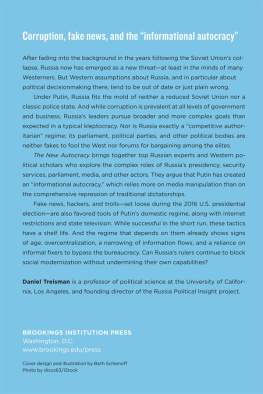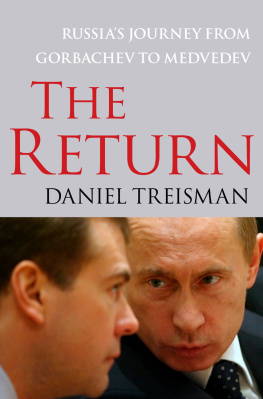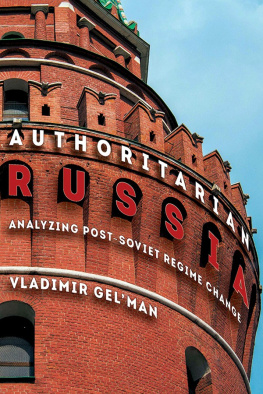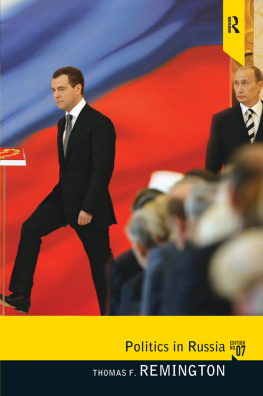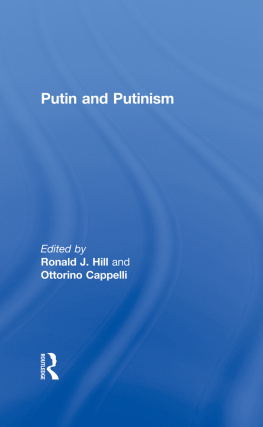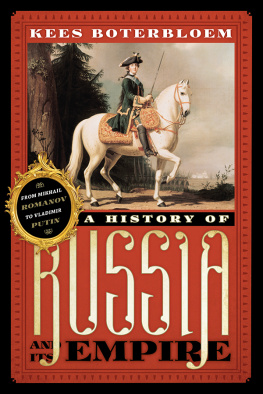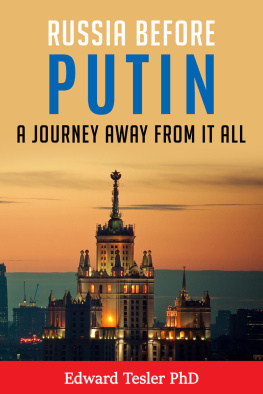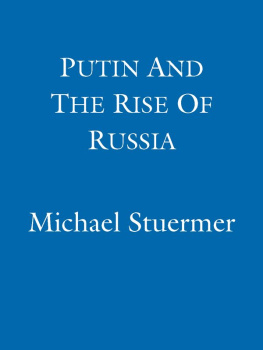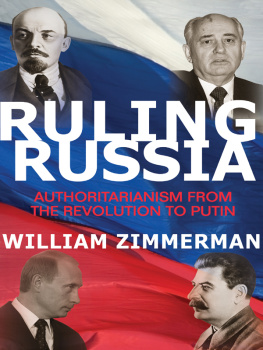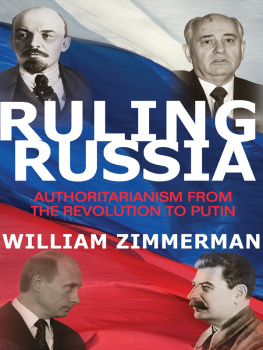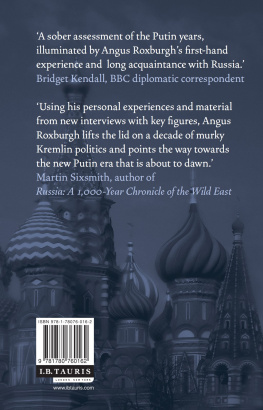INFORMATION, POLITICS, AND POLICY IN PUTINS RUSSIA
The New Autocracy
DANIEL TREISMAN
Editor
BROOKINGS INSTITUTION PRESS
Washington, D.C.
Copyright 2018
THE BROOKINGS INSTITUTION
1775 Massachusetts Avenue, N.W., Washington, D.C. 20036
www.brookings.edu
All rights reserved. No part of this publication may be reproduced or transmitted in any form or by any means without permission in writing from the Brookings Institution Press.
The Brookings Institution is a private nonprofit organization devoted to research, education, and publication on important issues of domestic and foreign policy. Its principal purpose is to bring the highest quality independent research and analysis to bear on current and emerging policy problems. Interpretations or conclusions in Brookings publications should be understood to be solely those of the authors.
Library of Congress Cataloging-in-Publication data are available.
ISBN 978-0-8157-3243-3 (pbk.: alk. paper)
ISBN 978-0-8157-3244-0 (ebook)
9 8 7 6 5 4 3 2 1
Typeset in ScalaPro
Composition by Westchester Publishing Services
Contents
Daniel Treisman
Maxim Ananyev
Ben Noble and Ekaterina Schulmann
Andrei Soldatov and Michael Rochlitz
Nikolay Petrov and Eugenia Nazrullaeva
Natalia Lamberova and Konstantin Sonin
Maria Lipman, Anna Kachkaeva, and Michael Poyker
Kirill Rogov and Maxim Ananyev
Ella Paneyakh and Dina Rosenberg
Anton Sobolev and Alexei Zakharov
Daniel Treisman
Preface
Russias seizure of Crimea from Ukraine in 2014 shocked observers around the world. It also surprised more than a few professional Russia-watchers. While in retrospect some saw a certain logic in the Kremlins actionand all knew of Moscows grievancesfew had predicted the move. To many, it suggested the urgent need to reexamine assumptions and gather new evidence about how Russias leaders currently make high-stakes decisions.
In the fall of 2014, with generous support from the Carnegie Corporation of New York, I recruited a team of experienced, Russia-based political analysts from academia, think tanks, and the press. I matched them up with promising emerging scholars, based mostly in the West, who, in their own work, were applying social scientific techniques to the challenge of understanding Russia. My hope was to capture synergiesbetween Russian and Western perspectives, accumulated knowledge and fresh approaches, local expertise and scientific method. This book is the result.
The team met at two workshop conferencesin Los Angeles (March 2015) and New York (June 2016)to plan our research and then to discuss drafts of the chapters. We are grateful to five U.S. scholarsLeon Aron, Timothy Frye, Michael McFaul, Graeme Robertson, and Joshua Tuckerwho offered invaluable advice at these events. (Of course, they bear no responsibility for errors or omissions.) For more on members of the team and links to their writings on Russia, see our website at www.russiapoliticalinsight.com.
To say that understanding Russias political decisionmaking is important is not to say that it is easy. In the more than three years since we began, the process has becomeif anythingeven more opaque. We have sought evidence from a variety of sourcesinterviews with current and former insiders, journalistic accounts and memoirs, official records, and data on everything from law production and official meetings to criminal prosecutions and the connections among major business people. Needless to say, we have struggled with problems of inference, knowing that what we see is only part of the picture. Throughout, we were guided by a commitment to questioning conventional wisdom and to reliance on observation and induction rather than to the imposition of any preconceived models.
We thank the Carnegie Corporationand, in particular, Deana Arsenian and Pat Nicholasas well as the UCLA Department of Political Science and Social Science Grants office for their help and support along the way. At Brookings, we are grateful to Bill Finan, Valentina Kalk, and two anonymous reviewers.
The book was made possible in part by a grant from the Carnegie Corporation of New York. The statements made and views expressed, however, are solely the responsibility of the authors.
Introduction
Rethinking Putins Political Order
DANIEL TREISMAN
How are political decisions made in Russia today? The increasingly tense relations between the worlds second nuclear power and the West make understanding that process particularly urgent. Yet many images popular in the media and academia, although capturing some element of Russias political scene, do not seem quite right.
To certain observers, the regime of Vladimir Putin looks like a spruced-up replica of the USSR of Leonid Brezhnev. the Soviet national anthem, the Russian president is now said to rule by means of what one analyst, perhaps tongue in cheek, calls a Politburo 2.0 (Minchenko 2013).
Others see the current regime as an offshoot not of the Soviet Union per se but of its most feared institutionthe State Security Committee (KGB), or, more broadly, the security and law enforcement agencies, whose officers and veterans are known in Russian as the siloviki . Putin, the onetime spy, is cast as the executor of a covert project to establish his former agencys dominance. Analysts portray the siloviki as a cohesive clan, now entrenched within both the Russian polity and the countrys corporate boardrooms (Petrov 2002; Kryshtanovskaya and White 2003, 2009; Treisman 2008).
To still others, the Putin regime is essentially a kleptocracy, whose leaders central aim is to loot the country without limit (Dawisha 2015, p. 3). Putin and his croniesmostly old friends from St. Petersburgare said to have enmeshed the state in nationwide networks of corruption. To understand Russian politics today, so this argument goes, one simply needs to follow the money.
While these three images emphasize the personal history and choices of Russias second president, a fourth image sees him as the instrument of something larger. Russian public life, it is said, is governed by sistema . What sistema literally the systemmeans depends on who is writing. In one view, it represents informal power networks that account for the failure to implement leaders political will (Ledeneva 2013, p. 4). In another, it is a style of exercising power that turns the countrys people into temporary operating resources (Pavlovsky 2016, p. 14). The various usages share the notion of something timeless, rooted in culture, that blocks reform and devalues individual rights.
Finally, political scientists who look at Russia often find in it an example of competitive authoritarianism, a type of regime that converts seeminglyade of democracy is constructed in part to earn respectability and Western aid.
These images point to some recognizable features of Russia under Putin. Yet, as a guide to the countrys politics and policy, they seem inadequate. Each highlights one aspect, while neglecting others. Each ignores much of what actually happens, day to day, in Russian government. By emphasizing continuities and cultural stickiness, the neo-Soviet, KGB state, and sistema interpretations create a misleading impression of stasis. They underplay the dramatic ways the country has changed over the past twenty-five years and imply a coherence that is hard to fit with the facts.
Like the Soviet Union, Russia today has a strong leader, a centralized state, superpower ambitions, and an aggressive foreign policy. Yet, unlike the USSR, it lacks a cohesive ruling party and a communist ideology. It hasfor the most partopen borders and a market economy. Indeed, many of its leaders are eager capitalists, with their own businesses on the side (Lamberova and Sonin, this volume). The Soviet Politburo after Joseph Stalin, although dominated by the general secretary, contained a number of political heavyweights with their own bureaucratic resources. There is nothing comparable in Putins Russia. And, for all the propaganda on todays Kremlin-controlled television, the country remains far more open to information than in Soviet times.
Next page
